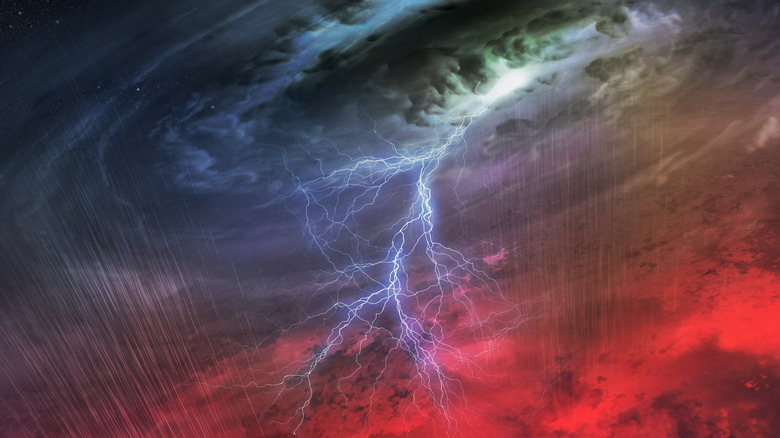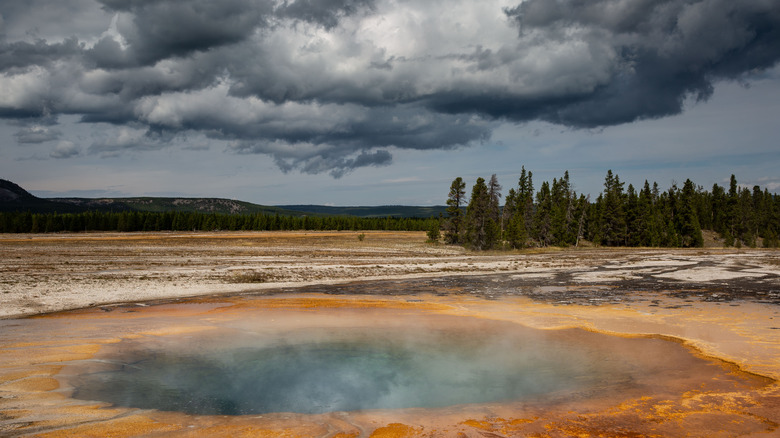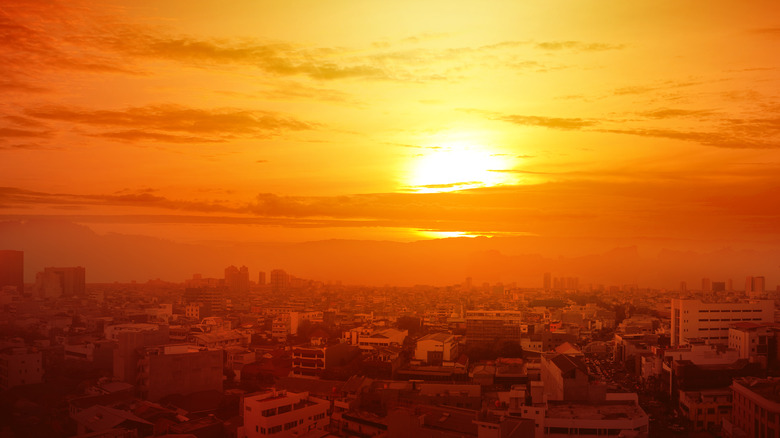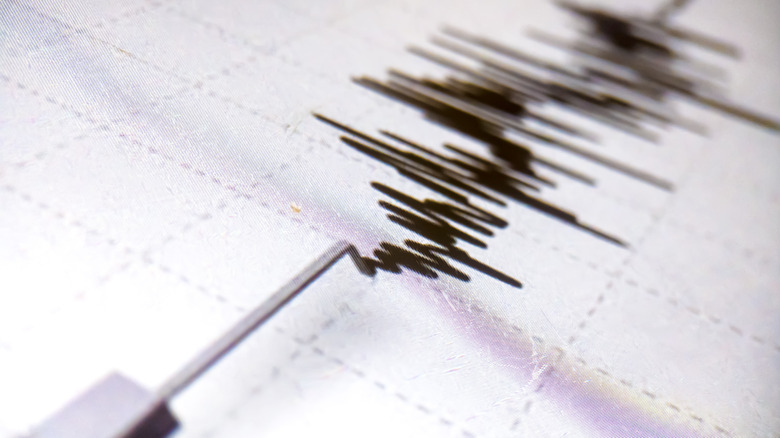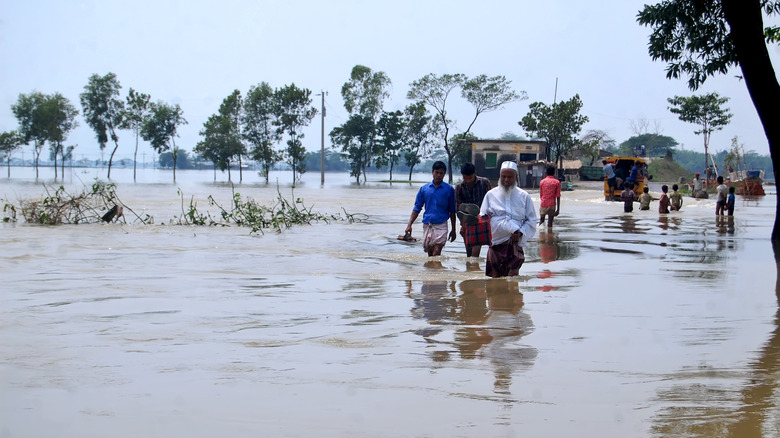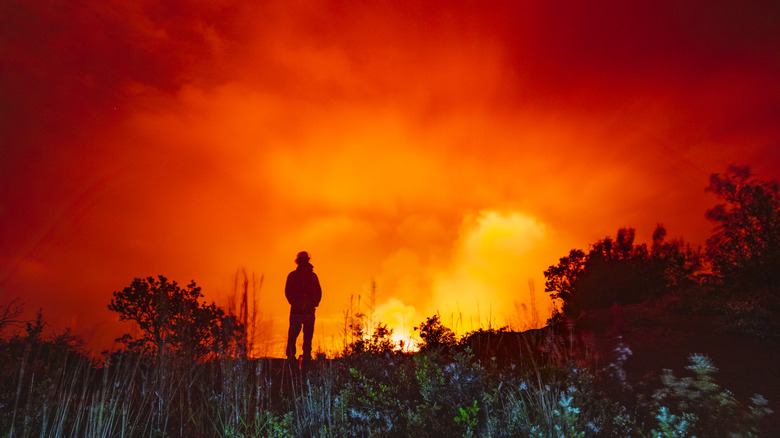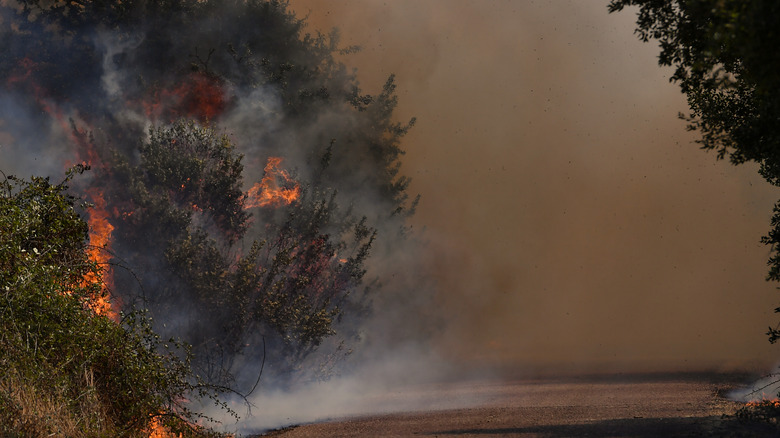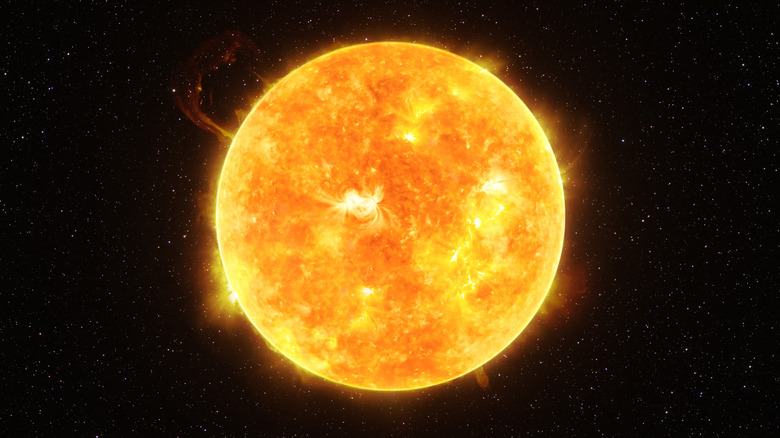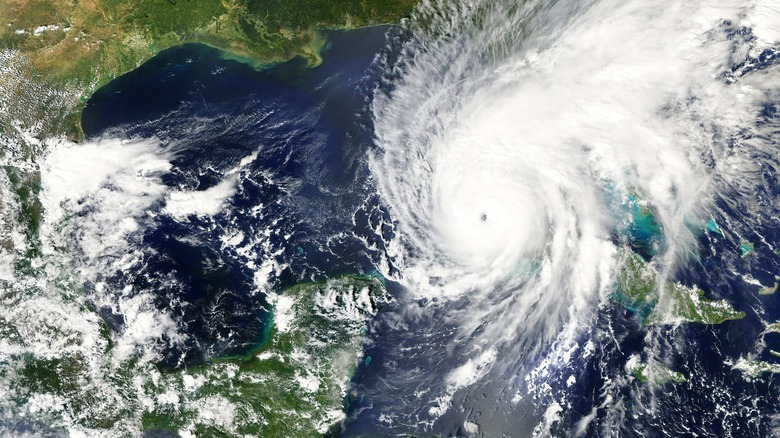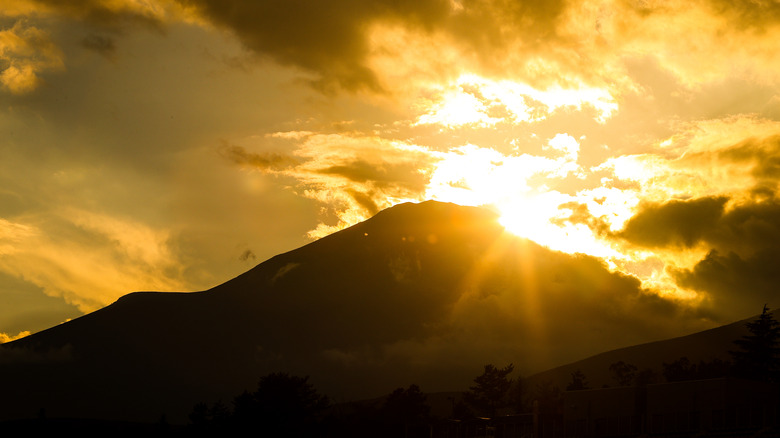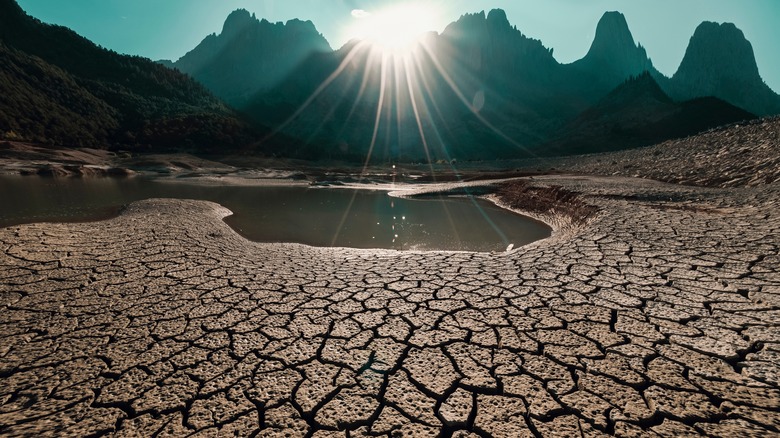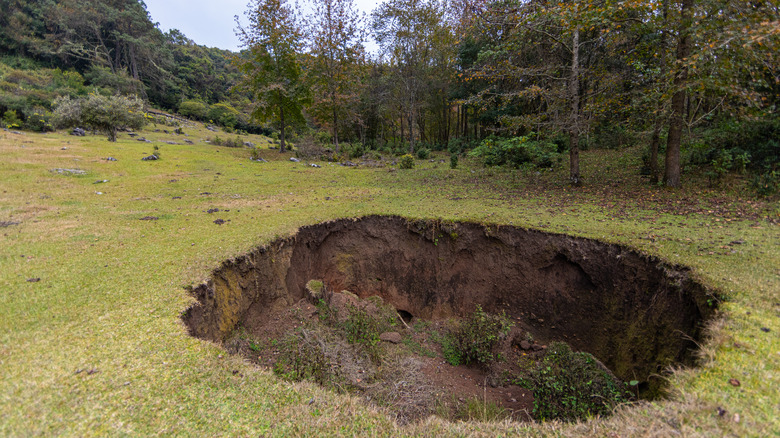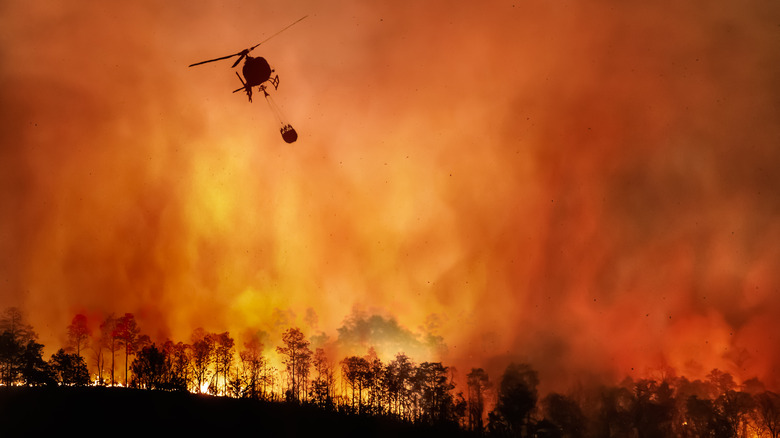Natural Disasters That Haven't Happened Yet, But Could
Hurricanes. Fires. Floods. Natural disasters occur around the world every year, costing lives, destroying homes, and costing billions. According to research shared by the United Nations, in the last 50 years, the number of natural disasters occurring globally has tripled.
Some potential disasters, like the possibility of a volcanic super-eruption in the heart of the United States, are unlikely, per Vox. Other natural disasters like wildfires are inevitable, but the severity and frequency can vary (via NBC News). With increasing global temperatures and rising sea levels, the planet is going to experience more natural disasters, and more intense ones, than ever before. "It's going to get a lot worse," Georgia Tech climate scientist Kim Cobb is quoted as saying by PBS, "I say that with emphasis because it does challenge the imagination."
As noted by the New York Times, radically cutting emissions may dramatically reduce the number of natural disasters that are expected to hit communities around the globe. As detailed by ready.gov, a website run by the U.S. government, individuals can help keep themselves and their families safe by knowing the risks of natural disasters in their region and planning ahead. These are some of the natural disasters that haven't happened yet, but still could.
Yellowstone's supervolcano could erupt
Under Yellowstone National Park there is a reservoir of magma and molten rock. This provides the park with geysers and hot springs which support unique ecosystems and draws tourists from around the world. Theoretically, it could also cause untold devastation.
The Yellowstone Caldera is a supervolcano that is thousands of times more powerful than the average volcano. It hasn't erupted in 664,000 years, but if it did, it would cause massive destruction throughout the American Midwest. A super-eruption would send splintered rock and glass raining down across the midwest, killing people and animals, smothering crops, and destroying homes. The worst-case scenario predictions show enough ash to bury Texas under five feet of ash.
As explained in a Vox interview with Jacob Lowenstern, one of the co-authors of a 2014 scientific paper on what a major eruption of the Yellowstone Caldera might look like, that kind of eruption has only occurred three times in history. It's unlikely that a super-eruption will happen any time soon — or possibly ever again, though. As stated by the USGS, the magma chamber under Yellowstone is estimated to be only between 5% and 15% molten. It's possible that there isn't even enough magma there to erupt. While still unlikely, it's more likely that there could be smaller volcanic events, like lava flows, smaller eruptions, and earthquakes than one which buries the United States in ash.
Extreme heat waves predicted to hit our cities
"Heat waves are probably the most underestimated type of potential disaster because they routinely kill a lot of people," Daniel Swain, climate scientist at the University of California at Los Angeles told Reuters. "We just don't hear about it because it doesn't kill them in, to put it bluntly, sufficiently dramatic ways."
The number of hot days breaking record temperatures around the world is increasing, while the number of cold days is going down. In the United States, heat waves are becoming more and more common, reaching intensities only matched by those seen during the devastating "Dust Bowl." In big cities, these heat waves could quickly become deadly. The term "urban heat island effect" refers to a phenomenon that occurs in cities when it gets too hot. As described by the EPA, the large amount of pavement and buildings absorb and hold in the heat. As described by C2ES, this makes the heat more intense during the day and prevents it from cooling down overnight like more rural areas do. The high heat also affects air quality, increasing ground-level ozone and creating smog. This can be particularly dangerous for children, the elderly, and those with chronic health issues.
It's predicted that between 2036 and 2065 many areas of the United States will have between 20 and 50 days over 90 degrees Fahrenheit every year, and some could have more than 60. In order to combat the increasing temperatures, some cities are looking to plant trees and vegetation.
An earthquake could devastate the coastal Northwest
North of the famous San Andreas fault is another fault line known as the Cascadia subduction zone. It stretches 700 miles from Vancouver Island in Canada to Cape Mendocino, California. It is believed that other than the 2010 earthquake in Haiti, this could be the site of the worst natural disaster in North American history.
The odds of a serious Cascadia earthquake within the next 50 years are one in three, while the worst-case scenario is approximately one in 10. As described in the New Yorker, the next major earthquake there could force the northwest edge of the continent to drop by "six feet and rebound thirty to a hundred feet" in the span of several minutes. The coast would likely be hit by a wave over 100 feet high. It has been estimated that more than 10,000 people could be killed and another 27,000 could be injured.
Bangladeshi cities could be washed away in devastating floods
During Bangladesh's monsoon season flooding is common — but in 2022, the rains lasted longer than they have in over 100 years. As stated by Afiya Rahman for The Harvard Crimson, more than 60% of Bangladesh is less than 15 feet above sea level, and the sea is rising. The flooding has become catastrophic, and it's only going to get worse.
"Instead of having moderate rains spread out through the monsoon season, we have long dry periods intermittently with short spells of heavy rains," Roxy Mathew Koll, a climate scientist at the Indian Institute of Tropical Meteorology told Reuters. "When it rains, it dumps all that moisture in a few hours to a few days."
In 2022, more than 7 million Bangladeshi people were impacted by severe floods that destroyed entire towns, washing away homes and crops. Much of the flood water was extremely contaminated, meaning that although entire communities were under water, there was nothing for survivors to drink. According to IPS, almost 70 people were killed. As described by Aljazeera, this tragedy may be only a preview of disasters to come. Around 160 million people live in Bangladesh, and it is predicted that by 2050, more than 13 million people living near to the country's coasts may be displaced.
A Hawaiian volcano could fall into the sea
In 2018, a story about the possibility of the Kilauea volcano of Hawaii's Big Island breaking off into the ocean and causing massive tsunamis went viral. If the cliff at the Southern side of Hawaii were to collapse, it is believed that it would generate an earthquake among the most powerful ever recorded, followed by a megatsunami with waves over 100 feet high.
As explained by a BYU-Hawaii professor in an interview with Ke Alaka'I, this is unlikely to happen any time in the next thousand centuries — but it is true that earthquakes and Kilauea eruptions shift the island's coast. As stated by UC Berkeley's Seismology Lab, this movement is called the Hilina Slump. In 1868, this movement caused a tsunami with waves up to 60 feet tall. In 1975, a large earthquake moved the slump approximately 11 feet towards the sea. Modern eruptions, however, have been extremely slow, with most individuals able to evacuate at their own pace without too much threat.
Wildfires are predicted to burn around the globe
In the year 2020, wildfire started by lightning strikes spread through Australia in what has been called among the "worst wildlife disasters in modern history" (via NBC) affecting nearly 3 billion animals. Shortly after, an Arctic heat wave sparked fires in typically frigid Siberia. As noted by NBC, experts predict that supercharged wildfire seasons and blazes that lay waste to ecosystems will only become more common.
Many regions experience fire seasons, but they are becoming increasingly intense and lasting longer than ever before. Higher temperatures and drought are increasingly becoming the norm around the world, which creates the perfect conditions for a spark to turn into a devastating fire. Dried out vegetation catches and burns easily, making it incredibly difficult to extinguish the fires once they begin. Fires are traveling farther, as well. As noted by C2ES, in some areas of the United States, up to 600% more land may burn every year as average temperatures rise.
Experts say that plans for dealing with wildfire require an update for the changing times if these blazes are going to be controlled. Matthew Hurteau, a biologist specializing in forest ecosystems, wildfire, and climate change, told NPR: "A lot of the planning tools that fire managers rely upon for planning prescribed burns were built under a climate that no longer exists."
A solar storm could knock out the power
The Sun is at the center of our solar system, and without its heat and light there would be no life on planet Earth. As described by NASA, however, events in the Sun can have other impacts for those living on the planet's surface, and not all of them are positive. Solar storms are changes that occur on the sun that affect the rest of the solar system, including Earth, such as intense bursts of radiation called solar flares which explode from the Sun, and geomagnetic storms (the interaction of Sun explosions and Earth's magnetic field).
As stated by DW, solar storms are ranked on a scale of one to five. Storms classified as level one are unlikely to be noticed by most on Earth, though they can cause spectacular northern and southern lights. Higher level solar storms could cause serious problems, however, and they're likely to increase in the coming years. Intense solar storms are a serious threat to technology. A serious solar storm has the potential to cause massive blackouts, disrupt phones and satellites, and possibly even knock out the internet.
In 2014, physicist Pete Riley of Predictive Science Inc. determined that there was a 12% chance of a major solar storm hitting the planet by 2024. The sun goes through 11-year cycles, and it is believed that solar flares will be at their most intense for this cycle in the year 2025.
Powerful hurricanes are likely to come in off the ocean
Deadly storms are becoming increasingly common, and are likely to get more intense in the future. According to NOAA (quoted by NASA) in the 25 years between 1995 and 2020, 17 included unusually intense hurricane seasons around the globe.
One reason for this is increasing temperatures. For a hurricane to form, the surface of the sea needs to be hotter than 79 degrees Fahrenheit. On the Atlantic, the number of storms haven't necessarily increased — in fact some models predict that there may not be more hurricanes in general over time — but it is believed that they will become deadlier. As described by CNN, warmer temperatures mean more rainfall during these storms. Research has shown that hurricanes are already beginning to bring heavier rains with them, and over time, it's going to get more severe.
Another reason these storms are becoming more dangerous is rising sea levels. One of the most deadly risks from these hurricanes is sudden flooding caused by storm pressure and winds, known as a "storm surge." In the last 25 years, ice sheets and glaciers have melted, leading to sea levels that are several inches higher in general. When storm surge occurs, those few inches can make all the difference, sending catastrophic floods even further.
Mount Fuji might erupt
Mount Fuji is a famous symbol of Japan, but it could someday become the site of a major natural disaster. As stated by Britannica, Mount Fuji is the tallest mountain in Japan, and for some it has profound spiritual significance. Thousands climb Mount Fuji every year. It is also a volcano. While it hasn't erupted since 1707, experts say that could change soon.
If Mount Fuji were to erupt, it would be catastrophic. As stated by Japan Forward, blankets of volcanic ash could crush buildings. There would be massive power outages. Communities at the base of the mountain would be in the path of lava flows. In March of 2011, an earthquake caused the bedrock to crack above the reservoir of magma. As of 2022, The National Police Agency is preparing for the threat. As described by Japan Times, the government has already purchased almost 100,000 dust masks for possible use during rescue efforts after an eruption.
Global drought could lead to famine
In 2021, years of drought in Madagascar caused a devastating famine. Experts say that this could be a sign of things to come around the world.
Madagascar is a tropical island, but as global temperatures rise, weather patterns that have held stable for hundreds of years are changing. As described by Time, in recent years, Madagascar has experienced less rainfall, and the drought has severely impacted the farmers who rely on water to maintain their crops. As noted by Carbon Brief, the Madagascar drought may not have been directly caused by climate change as was originally suspected, but it isn't the first famine caused by rising temperatures. The Horn of Africa is in the midst of a hunger crisis, too. Droughts have led to failed crops and livestock die-offs, and according to experts, more are coming. Without change, there may soon be a global food crisis. Carin Smaller, executive director of a think tank working on world hunger told Politico, "I've been working in this sector now for more than 15 years and this for me is the worst crisis we've seen."
Changes to farming practices can make a difference. Providing local farmers, who are experts in food production, with irrigation systems, hardy livestock, and drought-resistant seeds may mitigate the effects of rising temperatures.
SInkholes might swallow communities
In the summer of 2022, a sinkhole opened up in New York City, sucking a parked van down into the earth. That year, there were almost 4,000 sinkholes reported across the city. New York isn't alone. In the United States, sinkholes are most common in Florida, where there have been six deaths when the ground suddenly opened up and swallowed individuals. Sometimes the bodies are never found. As noted by Smithsonian Magazine, a sinkhole even opened up in front of the White House. This is a global problem, and they are getting worse all around the world.
These disasters are extremely unpredictable and seem to form without warning, but their cause is well-known. Underground there are typically large areas of groundwater, but in droughts (which are becoming more and more common) the water dries up, creating empty caverns. Simultaneously, weather is becoming more unpredictable and storms are becoming more intense. If a storm brings heavy rains, it can collapse. As described by the Independent, cave-ins also occur when unusually heavy rains speed up erosion and overload stormwater pipes.
As noted by The World, tapping underground wells in times of drought can make this situation worse. In central Turkey, this has led to more than 2,000 sinkholes over a short period of time. Rising sea levels also lead to rising groundwater levels in coastal areas. As the risk of flooding increases, more sinkholes may open up.
Simultaneous disasters are expected to ravage the globe
Any one of these disasters could be deadly, cost billions, and take a long time to recover from. The climate crisis means that dealing with natural disasters one at a time may no longer be an option. Between rising temperatures, worse storms, and rising oceans, it's possible that multiple catastrophes will happen at once. As described to NPR by former FEMA administrator Craig Fugate, the number of disasters is already increasing. "I've been doing this for over 30 years. I can remember when FEMA had really big disasters maybe every four or five years. Not every year. Certainly not multiple in one year."
Researchers say that by the year 2100, tropical coastal areas such as the Atlantic coast of South America might have to deal with as many as six natural disasters at any one time. Other areas won't be much better off. The same study (quoted by the New York Times) predicted that New York would likely experience four disasters at a time. Drier regions are likely to experience severe droughts, wildfires, and heat waves, while areas that are already wetter are likely to experience serious storms and floods.
As seen in an interactive map associated with research from Camilo Mora of the University of Hawaii at Manoa, by radically reducing carbon emissions, many of these crises can be avoided, cutting the number of natural disasters by 50% or more.
